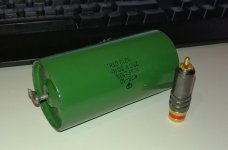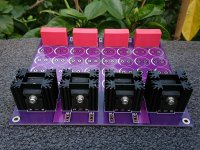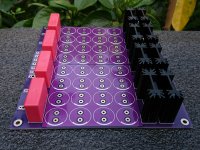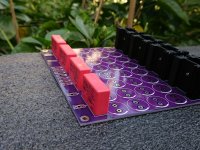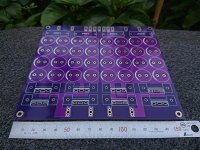Do you think it is the voltage rating difference or the capacitor type that caused this? Do you not have different voltages of the same cap to try? Two parameter changes muddies the waters somewhat.I conducted a quick charge and discharge comparison between a new/old stock Elna Hifi grade 100 volt dc unit vs a new Nichicon Gold tone 35 volt dc one...first I charged then up through resistance(same) to working voltage to reform them for a time and observe the miliamp meter to see current dropping to zero...then discharged them both and observed time it takes for charge voltage to drop below threshold of one volt.Then I repeat experiment but charge both to only 35 volts...out come:The Elna capacitor discharged noticeably much quicker than the Nichicon...I have to conclude that this would probably be audible to your ear...maybe if both were allowed to be formed up for a longer period of time maybe there wouldn't be much difference ...If one owned mono blocks this could be A and B'd and reported on.
Re:63v vs 40v caps
I should have further qualified about caps I used and describe my Elnas used as having low resistance screw terminals as apposed to the 35 volt Nichicons that have snap in style terminals......because of finances one is forced to use new old or used components ...I like the challenge of using whatever is available and subsitituting parts over time to achieve synergy...just don't change too many things all at once otherwise you may have to reverse everything in order to get back(sound wise) to where you were and start over....uhm....what was your question again?Ha,ha...
I should have further qualified about caps I used and describe my Elnas used as having low resistance screw terminals as apposed to the 35 volt Nichicons that have snap in style terminals......because of finances one is forced to use new old or used components ...I like the challenge of using whatever is available and subsitituting parts over time to achieve synergy...just don't change too many things all at once otherwise you may have to reverse everything in order to get back(sound wise) to where you were and start over....uhm....what was your question again?Ha,ha...
Whether a cap has whatever terminations doesn't much matter as long as the device used can be safely used in the chosen circuit...I read that ARC liked to use Electro's that worked into circuits that would see voltages closer to their working voltage ratings....can,t remember the complete reason(this would be an area to investigate further on).
Hello,
Any opinion about Kemet 550V ALC Series please ?
Can I use them without risk on the filter LC/RC for a psu @450V ? (B+ for EL156)
Thank you in advance !
ALC10A121CC550 KEMET | Mouser France
Any opinion about Kemet 550V ALC Series please ?
Can I use them without risk on the filter LC/RC for a psu @450V ? (B+ for EL156)
Thank you in advance !
ALC10A121CC550 KEMET | Mouser France
Thank you for your answer. I know, but well the security marge for peak voltage is ok ?
For exemple : For 450 V, some people tell me a 500 VDC rated capa is too close to their limit.
And well thoses Kemet 550V one are they good / acceptable ?
ESR : 2874 mOhms
Z : 2506 mOhms
Rejection current : 1.14 A
www.mouser.com/ds/2/212/KEM_A4020_ALC10-1103920.pdf
For exemple : For 450 V, some people tell me a 500 VDC rated capa is too close to their limit.
And well thoses Kemet 550V one are they good / acceptable ?
ESR : 2874 mOhms
Z : 2506 mOhms
Rejection current : 1.14 A
www.mouser.com/ds/2/212/KEM_A4020_ALC10-1103920.pdf
Last edited:
Hi, anyone have any more thoughts/experience with regards to this.I read that ARC liked to use Electro's that worked into circuits that would see voltages closer to their working voltage ratings...
Like if using 23v rails is it better to use 25v caps or 40v caps.
Best regards
This has been my thinking as well. On the other hand, running 23v on 63v caps, some say that having too high safe margin will dry out the caps faster. Any thoughts on this.
Reason being that Epcos B4155 has 63v as lowest value at 10000uf.
Epcos B4155 does have 22000uf 40v, but higher uf value will supposedly give a slower amp?
Again any thoughts on this?
The output will be running on 23v 900 mA.
Thanks.
Reason being that Epcos B4155 has 63v as lowest value at 10000uf.
Epcos B4155 does have 22000uf 40v, but higher uf value will supposedly give a slower amp?
Again any thoughts on this?
The output will be running on 23v 900 mA.
Thanks.
I was browsing through the inventory at a (the) local electronics supply, where they keep surplus parts from eons ago on their shelves. A pair of large, shiny capacitors caught my attention, and when i picked them up, they were extremely light weight, I shook them and they rattled. I have no idea how old they are, but some of the film caps there are over 40 years old.
Are probably still on the shelf there...
Are probably still on the shelf there...
Have to check cap condition,DC working voltage rating(usually higher than what the cap will see in use),length ,height and width,terminal spacing,etc; before purchasing ...then look for suitable candidates online.Choose candidates with low esr and use a variac through a bridge rectifier to dial up to the working DC voltage on each cap (called reforming the cap)...with a meter observe how long it takes to discharge each cap when you remove power and time how long it takes...caps should be charged at least once a month...I forget the formula for how long to charge them per time on the shelf.When charging observe the jump in current on voltage application as there is a lag in response as the cap under test accepts forms up to the applied voltage and current will drop to zero as this happens...the longer it takes to form tells you how long this cap has been on the shelf...If after being charged for a long enough time and "it" is still leaking current,the,it might be e great ideal to discard said cap...oh,and don't for get to use a suitable load in line with your Plus line to your cap(calculate for whatever current you think will be useful and determine a suitable resistor and wattage rating)...I use a suitable variable DC power supply with lots of current reserve for charging with...If others have any suggestions,please chime in...Good Luck !
Probably a good idea to have a variable something because of the cap charging current..to hit an uncharged cap may exceed the ability of your pwr supply to provide the neccessary current ...just wait till you start blowing fuses or somethin else...then you will know what I mean...
This caveat applies more to big caps(power supply)...expect it will take more current to charge them...and of course...the bigger the capacitance(given in micro farads or farads) the more demand on the pwr supply...This is why a variable regulated supply is ideal...start charging from zero volts but keep your eye on the miliamp meter for draw...
- Home
- Amplifiers
- Power Supplies
- Best capacitors for power supplies update
